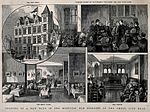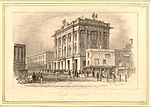Ironmonger Row Baths
Grade II listed buildings in the London Borough of IslingtonPublic baths in the United KingdomSwimming venues in LondonTourist attractions in the London Borough of Islington

Ironmonger Row Baths were built as a public wash house and later upgraded to a Turkish Bath. They are located at Ironmonger Row, in the St Luke's district, near Old Street, Islington, London.
Excerpt from the Wikipedia article Ironmonger Row Baths (License: CC BY-SA 3.0, Authors, Images).Ironmonger Row Baths
Norman Street, London Finsbury (London Borough of Islington)
Geographical coordinates (GPS) Address External links Nearby Places Show on map
Geographical coordinates (GPS)
| Latitude | Longitude |
|---|---|
| N 51.526643 ° | E -0.09483 ° |
Address
Ironmonger Row Baths
Norman Street 1
EC1V 3AA London, Finsbury (London Borough of Islington)
England, United Kingdom
Open on Google Maps









